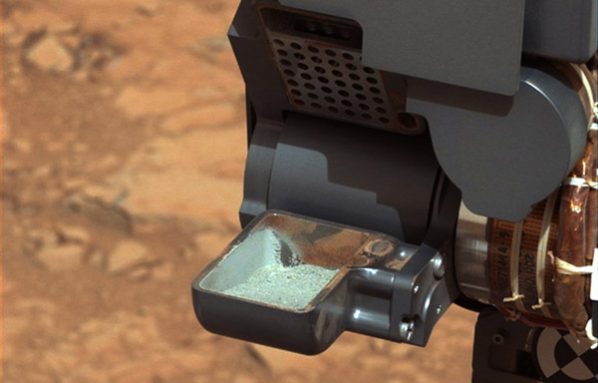Martian microbes, maybe
Billions of years ago, Mars could have been teeming with very small Martians

In February, NASA’s Curiosity rover made history when it plunged a drill into the Martian surface to collect a powdery rock sample. Scientists now say that those bits of rock show the Red Planet may have been able to support life billions of years ago.
Curiosity didn’t find life. It didn’t stumble over footprints or alien bones. But the rock contains clues to the planet’s ancient history. Scientists already knew that a long time ago, Mars had freshwater. Life as we know it requires water. The recently collected rock samples provide evidence that the planet’s ancient aquatic environment might have been able to support microbes.
“We have found a habitable environment,” John Grotzinger told Science News. Grotzinger studies rocks for signs of possible life and is a project scientist for the Curiosity rover. He also teaches geology at the California Institute of Technology in Pasadena.
Curiosity’s adventure began in August when it landed in Gale Crater. The giant, bowl-shaped formation hosts a 5-kilometer (16,400-foot) mountain in its middle. The rover soon rolled into an area now called Yellowknife Bay. It looks like a place where a stream once spilled into a larger body of water. There, Curiosity gathered its first sample.
“Mars has written its autobiography in the rocks of Gale Crater,” said scientist Michael Meyer. “Chapter One is Yellowknife Bay.” Meyer leads the Mars Exploration Program at NASA’s headquarters in Washington, D.C.
Curiosity’s drill allows the rover to explore below the planet’s famous reddish-brown surface. That means the rover can gather rocks where they formed, rather than where they’ve been blown by strong Martian winds. After Curiosity scooped up the rock, two onboard tools identified its chemical recipe.
The rock contained six common elements that could have supplied energy to Martian microbes, Grotzinger said. On Earth, he noted, microbes can feed on these elements. In the distant past, maybe they did on Mars, as well.
This rock marks an exciting start to Curiosity’s exploration of our solar system’s fourth planet from the sun. The rover — the biggest yet sent to Mars — is just getting started. Scientists need more samples to be sure those elements exist elsewhere on Mars (and weren’t simply carried there from Earth by the rover itself). These studies can give scientists an idea of what was happening when Mars was warmer and wetter, billions of years ago.
Power Words
geology The science that deals with Earth’s physical structure and substance, its history and the processes that act on the planet. Planetary geology is the science of studying the same things about other planets.
autobiography The story of the author’s life, written by the author.
element Each of more than one hundred substances that cannot be broken down into simpler substances.
crater A large, bowl-shaped cavity in the ground or on the surface of a planet or the moon. They are typically caused by an explosion or the impact of a meteorite or other celestial body.
NASA rover A carlike vehicle designed to travel across the surface of the moon or some planet without a human driver. Some rovers also can perform computer-driven science experiments.







